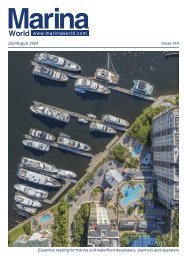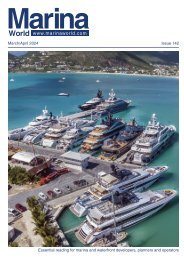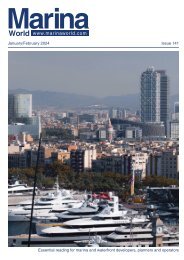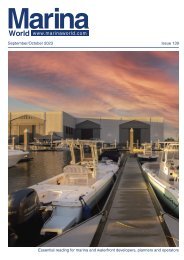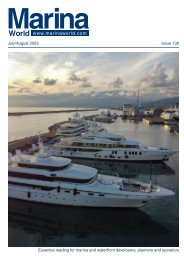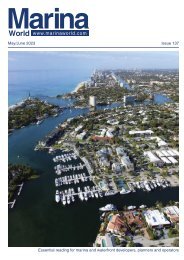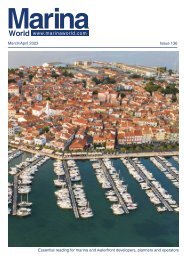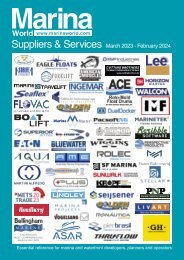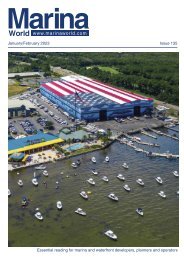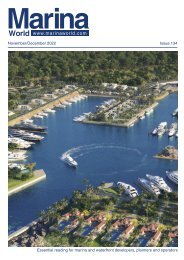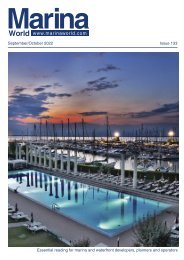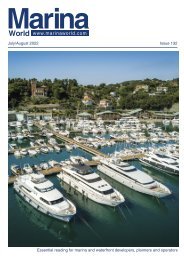You also want an ePaper? Increase the reach of your titles
YUMPU automatically turns print PDFs into web optimized ePapers that Google loves.
PRODUCTS, SERVICES & PEOPLE<br />
Mooring pontoons<br />
the smooth way<br />
The DualDocker mooring system was developed to make mooring up in a<br />
marina berth an easier and infinitely more stable experience for boat owners<br />
who felt this part of boating to be particularly challenging. The concept has<br />
since been further engineered as a heavy duty mooring system capable<br />
of keeping floating homes, floating pontoons and any other water-based<br />
structures secure.<br />
In principle, DualDocker is an<br />
alternative solution to traditional<br />
methods such as chains and piles. Its<br />
main strength is its ability to absorb the<br />
forces that impact on a floating pontoon<br />
- unlike a pile, for example, which<br />
has virtually no damping capacity.<br />
DualDocker completely avoids the build<br />
up of kinetic energy caused by wind,<br />
waves or current, and any wake energy<br />
from the docking of ships and yachts.<br />
It is a highly damped mooring solution<br />
without play.<br />
Manufactured in Austria using top<br />
quality materials and available to ship<br />
worldwide, the system is extremely<br />
environmentally friendly as nothing is<br />
secured to the seabed or drags across<br />
the seafloor.<br />
New heavy-duty systems can be<br />
used to secure aluminium, steel and<br />
concrete pontoons and gangways<br />
in a manner that is safe, has no<br />
visual impact and requires very little<br />
A DualDocker pontoon mooring solution<br />
installed in Corsica boosts the number<br />
of recreational berths.<br />
maintenance. It can be used to solve<br />
problems in challenging shaped sites or<br />
where sea levels significantly vary.<br />
Arrangements ideal for floating<br />
pontoons include the TriDocker and<br />
the V-Setup. TriDocker incorporates a<br />
docking arm at each end of the pontoon<br />
and one in the centre along either the<br />
length of a pier (for alongside mooring)<br />
or at the quay wall end of a stern-to<br />
mooring.<br />
The V-Setup replaces each of the<br />
arms with a V-shaped docking arm.<br />
This arrangement can also be installed<br />
on piles or on concrete mounts on the<br />
quay wall.<br />
In tandem with Swedish company<br />
Seaflex, DualDocker has also<br />
developed the 90m (295ft) floating<br />
pontoon concept (left). This moors a<br />
90m aluminium pontoon comprising six<br />
15 x 3m (49 x 10ft) sections. The result<br />
accommodates up to 30 boats of up to<br />
15m (49ft) in length and is moored by<br />
DualDocker at ‘landside’ and Seaflex<br />
‘seaside’. The system absorbs up to<br />
500kN, and pontoon movement is just<br />
0.05m (2in) in normal conditions and up<br />
to 0.25m (10in) in a heavy storm.<br />
Pontoon mooring installations to date<br />
range from heavy 5,000 ton floating<br />
structures in the UAE and a floating pier<br />
for heavy tug boats in Tangier, Morocco<br />
(12 DualDocker arms) to medium<br />
and smaller sized floating pontoons<br />
in marinas around the world, and<br />
numerous recreational pontoons and<br />
large, heavy floating homes worldwide.<br />
In addition to the significant benefits<br />
of high and instant damping capacity<br />
and the lack of mechanical parts<br />
requiring maintenance (no hydraulics,<br />
oil, gas or pneumatics), DualDocker is<br />
available in a choice of materials that<br />
offer great durability. The anodised<br />
aluminium alloy version is fully resistant<br />
to salt water and UV rays.<br />
www.dualdocker.com<br />
www.marinaworld.com - <strong>May</strong>/<strong>June</strong> <strong>2020</strong> 53



